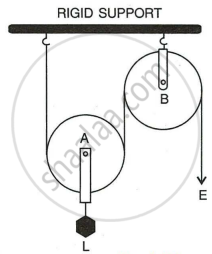Advertisements
Advertisements
Question
There is no gain in mechanical advantage in the case of a single fixed pulley. Explain, why the pulley is then used?
Solution
It is used only to change the direction of effort to a more convenient direction and to use one’s own weight for the effort.
APPEARS IN
RELATED QUESTIONS
From the diagram given below. answer the question that follows:

1) What kind of pulleys are A and B?
2) State the purpose of pulley B.
3) What effort has to be applied at C just raise the load L = 20 kgf?
(Neglect the weight of pulley A and friction)
Is the above pulley system an ideal machine or not?
State two functions of a machine.
Define the following term in reference to a gear system for Gain in speed ?
Define the following term in reference to a gear system for Gain in torque ?
In which direction does the force need to applied, when a single pulley is used with a mechanical advantage greater than one? How can you change the direction of force applied without altering its mechanical advantage? Draw a labelled diagram of the system.
The diagram below shows a pulley arrangement.
- Name the pulleys A and B.
- In the diagram, mark the direction of tension on each strand of string.
- What is the purpose of the pulley B?
- If the tension is T, deduce the relation between
- T and E, and
- E and L.
- What is the velocity ratio of the arrangement?
- Assuming that the efficiency of the system is 100%, what is the mechanical advantage?

Give reason for the following:
In a single fixed pulley, the velocity ratio is always more than the mechanical advantage.
Fig shown a block and tackles system of pulleys used to lift a load.

(i) How many strands of tackle are supporting the load?
(ii) Draw arrows to represent tension in each stand.
(iii) What is the mechanical advantage of the system?
(iv) When load is pulled up by a distance 1 m how far does the effort end move?
Complete the table.
| S. No | Types of Simple Machine | Example |
| 1. | Pulley | |
| 2. | Wheel and axle | |
| 3. | Wedge | |
| 4. | Inclined plan | |
| 5. | Lever | |
| 6. | Screw |
